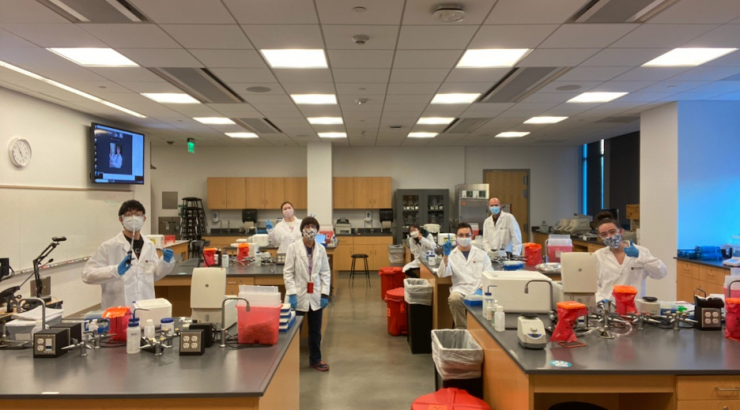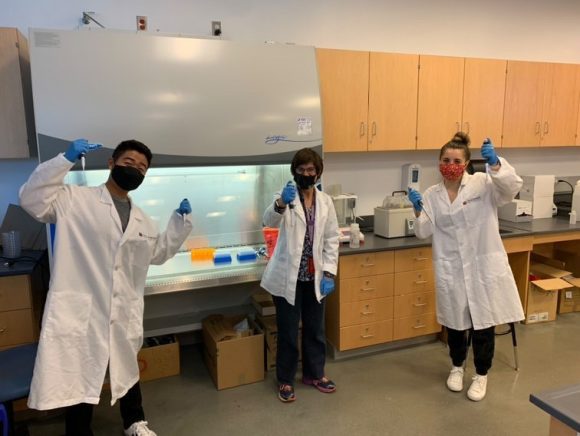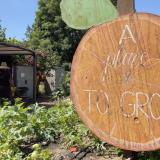
Navigating Hyflex Learning: Molecular Genetics Melissa Rowland-Goldsmith, Ph.D. details how the class operates.
March 29, 2021
As the University begins to reopen its classrooms, Schmid College was able to reopen a bit sooner to provide its students the opportunity to be inside a research lab once again.
Professors Melissa Rowland-Goldsmith, Ph.D., and Marco Bisoffi, Ph.D., returned to the Keck Center with a group of upper-division Schmid students to conduct a semester-long, course-base undergraduate research project. Students started the semester by using bioinformatic tools to analyze a RNA Sequencing dataset that includes genes that were differentially regulated in pancreatic cancer cells treated with or without a combination of pomegranate juice extract and caffeine. Through this analysis, groups of two students identified a gene of interest that they want to further study. Students review several primary journal articles to help formulate a hypothesis of why that gene would be regulated by this combined treatment and why that would inhibit cancer growth, and utilize the rest of the semester validating the RNA Sequencing findings by doing a different molecular biology technique, q RT-PCR.
Rowland-Goldsmith and Bisoffi work together to teach the course. Bisoffi providing the students with the lecture content, while Rowland-Goldsmith oversees the lab environment. The class is comprised of 25 students, the largest in class history, where all students have a wide knowledge base of molecular biology and biochemistry. This course is conducted in a HyFlex model, where 8 of the 25 students take the course fully online via Zoom and participate with the early “live” group. Then, after two hours, the second group does the experiment. When a group is not working in the lab, they are in breakout groups working on a different assignment for the class.
 In order to give all students the opportunity to learn from lab experiences, student Edena Khoshaba ‘21 sets up a video recording her lab station, so students can see every step of the lab process.
In order to give all students the opportunity to learn from lab experiences, student Edena Khoshaba ‘21 sets up a video recording her lab station, so students can see every step of the lab process.
“It has been fun navigating the hybrid classroom by walking through the lab as remote learners watch me perform the experiments with cameras around me, set up by our awesome lab TA, Alex Graden. As we all adjust to this new experience, we have learned a great deal from each other in terms of adaptability and resilience to overcome the challenges brought on by virtual learning,” said Khoshaba regarding her experience with the different learning environment.
Alongside Khoshaba, the course has a teaching assistant, Alex Graden, who helps facilitate the lab environments with Rowland-Goldsmith. Graden was carefully selected to fit this role, after completing his undergraduate degree at Chapman and previously completed this course his senior year. He has continued his research with the same pancreatic cancer cells the class has focused on with Bisoffi throughout his undergraduate years, which made him the perfect person for the role.
When asked about the composition of the course, Rowland-Goldsmith replied “It’s a lot of logistics, but it’s a dream come true to see this happen. I was nearly in tears of joy. Even with us all in masks, I could see the happiness in all the students’ eyes about how happy they were and how thankful they were to have this meaningful experience.”
Despite the curveball the pandemic has thrown to the world of education, there have been some positive outcomes, including the new technology available within the classroom. Rowland-Goldsmith and Bisoffi reflect on some of the advancements within the classroom, including the highly operational camera equipment faculty can now use to film lab experiments and record lectures for students to reference before exams or if they miss a class. Bisoffi highlights how students teach the professors about the ins and outs of Zoom, Canvas, and other online practices, demonstrating the beneficial relationship between students and professors.
Rowland-Goldsmith spoke about how Zoom can be utilized within the classroom after we return to in-person instruction. “Zoom will travel,” she says, calling attention to the ability of students, professors, guest speakers, and audience members to join a meeting from anywhere in the world. She reflects on a time she unknowingly had the opportunity to bring one of the founders of pharmaceutical company, Moderna, to her classroom through Zoom, even for a brief 15 minutes. The ability for students to hear experiences and learn about similar research from different perspectives within different fields allows for them to gain a greater understanding as to why what they are learning is so important, says Rowland-Goldsmith.

